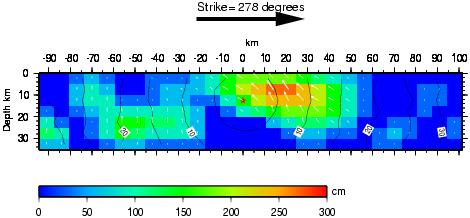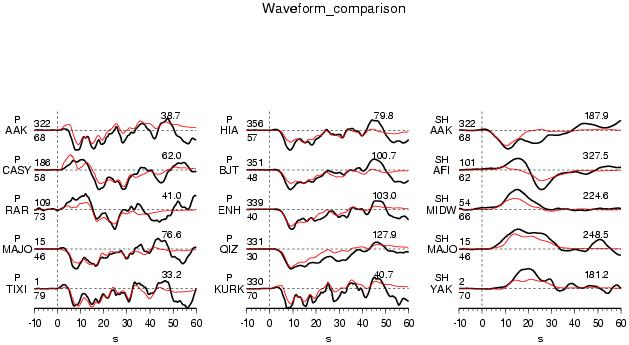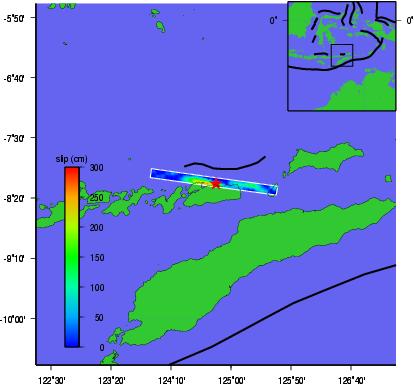Preliminary Result
04/11/11 21:26:44.98 (Mw 7.4) Kepulauan
Alor, Indonesia Earthquake
Chen Ji, Caltech
DATA Process and Inversion
We used the GSN broadband data downloaded from the IRIS DMC. We analyzed 10 teleseismic P waveforms and 5 SH waveforms selected based upon data quality and azimuthal distribution. Waveforms are first converted to displacement by removing the instrument response and then used to constrain the slip history based on a finite fault inverse algorithm (Ji et al, 2002). We use the hypocenter of the USGS (Lon.=124.791 deg.; Lat.=-8.137 deg.). The fault planes are defined using the quick moment tensor solution of the HARVARD.
Result
After comparing the waveform fits based on two planes, we find that the nodal plane (strike=278 deg., dip=68 deg.) fits the data better. The seismic moment release based upon this plane is 1.80x10**27 dyne.cm using a 1D crustal model interpolated from CRUST2.0 (Bassin et al., 2000).Cross-section of slip distribution

Figure: The big black arrow shows the fault's strike. The colors show the slip amplitude and white arrows indicate the direction of motion of the hanging wall relative to the footwall. Contours show the rupture initiation time and the red star indicates the hypocenter location.
Comparison of data and synthetic seismograms

Figure: The Data are shown in black and the synthetic seismograms are plotted in red. Both data and synthetic seismograms are aligned on the P or SH arrivals. The number at the end of each trace is the peak amplitude of the observation in micro-meter. The number above the beginning of each trace is the source azimuth and below it is the epicentral distance.

Figure: Surface projection of the slip distribution supperimposed on topography and bathymetry map ETOPO2. The ocean is plotted in blue and land is plotted in green. The black line indicates the plate boundary.
CJ's Comments:
Not Available YetDownload (Slip Distribution, Not available yet)
| SUBFAULT FORMAT | CMT SOLUTION FORMAT |
References
Ji, C., D.J. Wald, and D.V. Helmberger, Source description of the 1999 Hector
Mine, California earthquake; Part I: Wavelet domain inversion theory and resolution
analysis,
Bassin, C., Laske, G. and Masters, G., The Current Limits of Resolution for
Surface Wave Tomography in North America, EOS Trans AGU, 81, F897, 2000
GCMT project: http://www.globalcmt.org/
USGS National Earthquake Information Center: http://neic.usgs.gov
Global Seismographic Network (GSN) is a cooperative scientific facility operated jointly by the Incorporated Research Institutions for Seismology (IRIS), the United States Geological Survey (USGS), and the National Science Foundation (NSF).
‹Back to Slip Maps for Recent Large Earthquakes home page